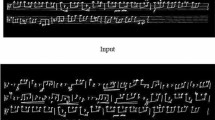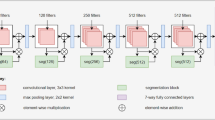Abstract
Character recognition of the script is the most vital step of Optical Character Recognition and the recognition accuracy directly affects the optical character recognition performance. Recognition of the script is fully achieved when all the components of the script are recognized completely. The conjunct character of the Devanagari script is one such component whose recognition is a challenging task. Researchers are adopting either segmentation-based or segmentation-free (holistic) recognition of these conjunct characters using structural features. This work provides an experimental study to compare between the holistic- and segmentation-based recognition of handwritten Devanagari conjunct characters. We propose a polygonal approximation-based novel segmentation approach that uses structural properties to decompose the conjunct characters of the Devanagari script to its constituent characters. This technique segments the conjunct character from the point where two basic shapes are joined to form the conjunct character and thus, segmentation accuracy is enhanced. Convolutional neural network and convolution neural network-based transfer learning are used for the recognition purpose. Convolutional neural network-Recurrent neural network hybrid architecture is also adopted to simplify the holistic approach and reduce the classification complexity. A comparative study is delineated between the methods on the basis of experiments conducted. The proposed method is observed to provide better results in terms of segmentation and recognition of conjunct characters in comparison to previously reported works.













Similar content being viewed by others
References
Jayadevan R, Kolhe SR, Patil PM, Pal U (2011) Offline recognition of Devanagari script: a survey. IEEE Trans Syst Man Cybern Part C (Appl Rev) 41(6):782–796
Bag S, Krishna A (2015) Character segmentation of Hindi unconstrained handwritten words. In: International workshop on combinatorial image analysis, pp 247–260
Pramanik R, Bag S (2020) Segmentation-based recognition system for handwritten Bangla and Devanagari words using conventional classification and transfer learning. IET Image Process 14(5):959–972
Shelke S, Apte S (2010) A novel multi-feature multi-classifier scheme for unconstrained handwritten Devanagari character recognition. In: International conference on frontiers in handwriting recognition, pp 215–219
Shelke S, Apte S (2015) A fuzzy based classification scheme for unconstrained handwritten Devanagari character recognition. In: International conference on communication, information and computing technology, pp 1–6
Bhalerao M, Bonde S, Nandedkar A, Pilawan S (2018) Combined classifier approach for offline handwritten Devanagari character recognition using multiple features. In: Computational vision and bio inspired computing, pp 45–54
Acharya S, Pant AK, Gyawali PK (2015) Deep learning based large scale handwritten Devanagari character recognition. In: International conference on software, knowledge, information management and applications , pp 1–6
Chakraborty B, Shaw B, Aich J, Bhattacharya U, Parui SK (2018) Does deeper network lead to better accuracy: a case study on handwritten Devanagari characters. In: International workshop on document analysis systems, pp 411–416
Deore SP, Pravin A (2020) Devanagari handwritten character recognition using fine-tuned deep convolutional neural network on trivial dataset. Sadhana 45(1):1–13
Garg NK, Kaur L, Jindal M (2011) The segmentation of half characters in handwritten Hindi text. In: International conference on information systems for Indian languages, pp 48–53
Thakral M, Kumar M (2014) Devanagari handwritten text segmentation for overlapping and conjunct characters—a proficient technique. In: International conference on reliability, Infocom technologies and optimization, pp 1–4
Shelke S, Apte S (2011) A novel multistage classification and wavelet based kernel generation for handwritten Marathi compound character recognition. In: International conference on communications and signal processing, pp 193–197
Ajmire P, Dharaskar R, Thakare V (2015) Handwritten Devanagari (Marathi) compound character recognition using seventh central moment. Int J Innov Res Comput Commun Eng 3(6):5312–5319
Kale K, Chavan S, Kazi M, Rode Y (2013) Handwritten Devanagari compound character recognition using Legendre moment: an artificial neural network approach. In: International symposium on computational and business intelligence, pp 274–278
Kale K,Deshmukh P, Chavan S, Kazi M, Rode Y (2013) Zernike moment feature extraction for handwritten Devanagari compound character recognition. In: Science and information conference, pp 459–466
Bansal V, Sinha R (2002) Segmentation of touching and fused Devanagari characters. Pattern Recognit 35(4):875–893
Qiao J, Wang G, Li W, Chen M (2018) An adaptive deep Q-learning strategy for handwritten digit recognition. Neural Netw 107:61–71
Madakannu A, Selvaraj A (2020) DIGI-Net: a deep convolutional neural network for multi-format digit recognition. Neural Comput Appl 32(15):11373–11383
Gupta D, Bag S (2020) CNN-based multilingual handwritten numeral recognition: a fusion-free approach. Expert Syst Appl 165:113784
Balaha HM, Ali HA, Saraya M, Badawy M (2021) A new Arabic handwritten character recognition deep learning system (AHCR-DLS). Neural Comput Appl 33(11):6325–6367
Avadesh M, Goyal N (2018) Optical character recognition for Sanskrit using convolution neural networks. In: International workshop on document analysis systems, pp 447–452
Aneja N, Aneja S (2019) Transfer learning using CNN for handwritten Devanagari character recognition. In: International conference on advances in information technology, pp 293–296
Sonawane PK, Shelke S (2018) Handwritten Devanagari character classification using deep learning. In: International conference on information, communication, engineering and technology, pp 1–4
Guha R, Das N, Kundu M, Nasipuri M, Santosh K (2020) Devnet: an efficient CNN architecture for handwritten Devanagari character recognition. Int J Pattern Recognit Artif Intell 2009:205
https://en.wikipedia.org/wiki/Devanagari. Accessed 23 Jan 2020
Otsu N (1979) A threshold selection method from gray-level histograms. IEEE Trans Syst Man Cybern 9(1):62–66
Bhattacharya U, Shridhar M, Parui SK, Sen P, Chaudhuri B (2012) Offline recognition of handwritten Bangla characters: an efficient two-stage approach. Pattern Anal Appl 15(4):445–458
Bhowmick P, Bhattacharya BB (2007) Fast polygonal approximation of digital curves using relaxed straightness properties. IEEE Trans Pattern Anal Mach Intell 29(9):1590–1602
Krizhevsky A, Sutskever I, Hinton GE (2012) Imagenet classification with deep convolutional neural networks. In: Advances in neural information processing systems, pp 1097–1105
Simonyan K, Zisserman A Very deep convolutional networks for large-scale image recognition. arXiv preprint arXiv:1409.1556
He K, Zhang X, Ren S, Sun J (2016) Deep residual learning for image recognition. In: International conference on computer vision and pattern recognition, pp 770–778
Deng J, Dong W, Socher R, Li LJ, Li K, Fei-Fei L (2009) Imagenet: a large-scale hierarchical image database. In: IEEE conference on computer vision and pattern recognition, pp 248–255
Graves A, Fernández S, Gomez F, Schmidhuber J (2006) Connectionist temporal classification: labelling unsegmented sequence data with recurrent neural networks. In: International conference on machine learning, pp 369–376
Hochreiter S, Schmidhuber J (1997) Long short-term memory. Neural Comput 9(8):1735–1780
Bottou L (2010) Large-scale machine learning with stochastic gradient descent. In: Proceedings of computational statistics (COMPSTAT), pp 177–186
Maaten LVD, Hinton G (2008) Visualizing data using t-SNE. J Mach Learn Res 9:2579–2605
Author information
Authors and Affiliations
Corresponding author
Ethics declarations
Conflict of interest
The authors declare that there is no conflict of interest.
Additional information
Publisher's Note
Springer Nature remains neutral with regard to jurisdictional claims in published maps and institutional affiliations.
Rights and permissions
About this article
Cite this article
Gupta, D., Bag, S. Holistic versus segmentation-based recognition of handwritten Devanagari conjunct characters: a CNN-based experimental study. Neural Comput & Applic 34, 5665–5681 (2022). https://doi.org/10.1007/s00521-021-06672-6
Received:
Accepted:
Published:
Issue Date:
DOI: https://doi.org/10.1007/s00521-021-06672-6




